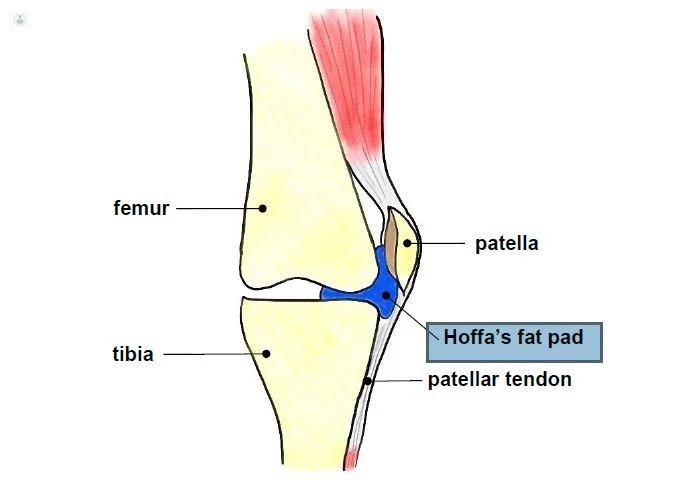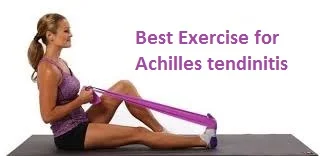Knee Range of motion exercise: Passive, Active & Active assisted exercise
Table of Contents
What is the Knee range of motion exercise?
- A Knee range of motion exercise refers to an activity aimed to increase the movement of the knee joint. The motion is influenced by many structures, likely configuration of bone surfaces within the knee joint, joint capsule, ligaments, tendons, and muscles acting on the knee joint. A range of motion exercise is called a”ROM” exercise. This is the capability of the knee joint to go through its complete spectrum of motion. The range of motion of the knee joint can be a passive range of motion exercise, active-assisted range of motion exercise, or active range of motion exercise.
Brief introduction of three types of the range of motion exercise
- The first one is the passive range of motion: The motion applied to the knee joint only by other an individual or people or a passive motion machine. When the passive range of motion is applied, the knee joint of the person receiving exercise is completely relaxed while the outside force moves the body part, such as the knee, throughout the available range of motion.
- The second one is the active-assisted range of motion: Knee Joint receives partial help from an outside force. This range of movement can result from the majority of the movement applied by the physical therapist or by an individual or people assisting the patient. It can be a half effort on the knee joint from each source, meaning the patient’s own effort and the external force.
- The last one, active range of motion: The movement of the knee joint provided entirely by the patient performing the exercise. In this
- type of exercise, there is no outside (external) force aiding in the motion while performing the activity.
The knee joint
- A Knee joint is a modified hinge joint, a type of synovial joint, that is composed of three functional compartments: a patellofemoral
articulation, consisting of a patella, or even “kneecap”, and the patellar groove on the front of the femur through which it slides; and the medial as well as lateral tibiofemoral articulations linking a femur, or thigh bone, with a tibia, the main bone of the lower leg. The knee joint is bathed in a synovial fluid which is contained inside the synovial membrane called a joint capsule. The posterolateral corner of the knee is the area that has recently been a subject of renewed scrutiny and research. The knee is the largest joint as well as one of the most essential joints in a body. It plays an important role in movement related to carrying the body weight in horizontal (running as well as walking) and vertical (jumping) directions. - Being the hinge joint, the main actions in the knee joint are flexion as well as the extension of the knee in the sagittal plane. It also allows limited medial rotation in the flexed position and in the last stage of extension, and lateral rotation when “unlocking” and flexing the knee.
What Is a goniometer?
- A goniometer is a metal or even plastic device with two arms that are used to measure the joint’s range of motion. The goniometer is placed along with the knee joint as well as measured by looking at the numbers to represent angular distance on the device. To measure the knee range of motion the physiotherapist most commonly use the goniometer. If the patient is suffering from a reduced range of motion in the knee joint, the physical therapist can use the goniometer to assess what the range of motion is at the starting assessment, and after that make sure the intervention is working by using the goniometer in subsequent sessions.

Types of Goniometers
- There are several types of goniometers is available, but of all the types, the universal goniometer is the most widely used.
- Universal Goniometer
This type of goniometer comes in two forms, the first one is a short arm and the second one is a long arm. A short arm goniometer is mainly used for smaller joints like the wrist, elbow, or ankle, while long arm goniometers are more accurate for the joints with long levers like the knee as well as hip joints. - Gravity Goniometer/Inclinometer
In this type of goniometer, one arm has the weighted pointer that remains vertical under an influence of gravity. - Software/Smartphone-based Goniometer
A smartphone as the digital goniometer has many benefits like availability, ease of measurement, application-based tracking of the measurements, as well as one-hand use. These types of goniometers use the accelerometers in phones to calculate the knee joint angles. - Arthrodial Goniometer
This type of goniometer is ideal for measuring cervical rotation, anteroposterior flexion, as well as lateral flexion of the cervical spine. - Twin axis electrogoniometer
The inter-rater, as well as intra-rater reliability of the electrogoniometer, is higher as compared to the universal goniometer but challenging to apply in the clinical evaluation of the patient, thus used more often for research purposes.
Techniques for using a goniometer
- It is mandatory that a single notation system is used in measuring the knee range by a goniometer. The neutral zero methods meaning 0 to 180- degree system is the most widely used method for measuring the knee range of the motion. The same goniometer may always be used to decrease the chances of instrumental error.
Position and stabilize the knee joint correctly
- Move the body part through its appropriate knee range of motion (ROM).
- Determine the knee joint’s end of the range of motion and end-feel as well.
- Then, palpate the appropriate bony landmarks.
- Align the goniometer with the knee’s landmarks.
- Read the measuring instrument properly.
- Record measurements correctly (both knee’s active as well as passive range of motion should be measured and recorded respectively).
- The range of motion of the knee joint should be measured in isolation, to avoid trick movements (simultaneous movement of another joint) and muscle insufficiency which may alter the reading as well.
Movements of the knee joint
- Knee flexion
- Knee flexion is a bending of the knee and bringing the foot toward the posterior thigh
- Knee extension
- Knee extension is the straightening of the knee from the flexion position.
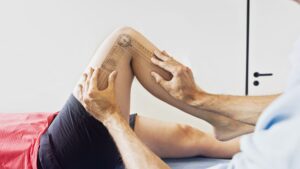
- Anatomical movement: Knee flexion
Axis as well as a plane for the motion: Frontal axis and sagittal plane - Testing position: The patient is in the supine position, with the knee in extension. The hip in o a degree of extension, abduction, and adduction as well. A towel roll can be kept under an ankle to allow a knee to extend as much as possible.
- Stabilization: Stabilize the femur to prevent rotation, abduction, or even adduction
Goniometer Placement - Axis location: lateral epicondyle of the femur
- Stationary arm: along the femur to the greater trochanter
- Movement arm: along with the fibula to the lateral malleolus of the ankle
Expected Findings
Normal range of motion:0degree to 135degrees
- Anatomical movement: Knee extension
- Testing position: The patient is in a prone position with a test-side ankle off the plinth.
- Goniometer Placement
- Axis location: lateral epicondyle of the femur
- Stationary arm: along the femur to the greater trochanter
- Movement arm: along with the fibula to the lateral malleolus of the ankle
- Expected Findings: the range of motion in prone is 0degree to -5 degrees in females (hypermobility).
Passive range of motion exercise
- The passive range of motion exercise is very useful for the knee joints that have become inactive because of an injury or even a paralysis attack. In the passive range of movement exercises, the patient does not perform any type of movement themselves; instead, a physical therapist or caretaker moves the lower limb or body part of the stiff knee joint, gently stretching muscles as well as reminding them how to move correctly. In most cases, therapeutic stretching exercises are also combined with the passive range of motion exercises to promote faster recovery of the stiff or flaccid knee joint. Here, the clinician stretches the soft tissue of the knee to relax the surrounding muscles as well as relieve tension. The passive range of motion exercises also assists in minimizing stiffness, rigidity, or even flaccidity in the knee joint that has been immobilized.
- The most common and safest passive range of motion(PROM)exercises are related to stretching the surrounding muscles with the goal to improve muscle flexibility. The most common way to do this exercise is with the use of a tool, namely the stretching strap. This will assist the patient to hold the stretch for a more sustained period of time. However, having a therapist who helps with the stretch is a more beneficial way to practice the passive range of motion(PROM) exercises. With this type of exercise, the trained professional moves a body into the stretch as well as holds it, with the intent to improve muscle flexibility.
- This is superior for some reasons.
The first one is a therapist understands proper limits and knows how far to go.
The second one is a clinician knows how long to hold the stretch.
The last one is the therapists are also trained to know if it is targeting proper areas to achieve more benefits. With that in the brain.
In which conditions the physical therapist should apply a passive range of motion exercise
- Passive range of motion exercises is typically used where there is a paralysis attack, when a patient is comatose, in the presence of the healing fracture, or even if the pain is elicited while an active muscle contraction. One of the major goals of the passive range of motion exercise is to counteract the detrimental effects of immobilization. However, it is essential to remember that passive range of motion exercise cannot prevent muscle atrophy.
Some benefits of the passive range of motion exercise
- Passive range of motion exercise not only helps in promoting healthy joint functionality but also benefits the patient in decreasing pain, increasing healing, restoring as well as maintaining range of motion in affected knee joints, and building muscle mass, allowing for great blood flow as well as helps in improving oxygen levels as well.
Some guidelines for passive range of motion exercise for the knee joint
- Passive range of motion can be done in a supine or even in a sitting position.
- Support the weight of the leg at all times while performing the knee movement.
- Support above and below the knee joint the patient is moving.
- Keep the movement slow and smooth.
- Do not force the movement if the knee muscle or knee joint is stiff.
- The physiotherapist should move only as much as the knee muscle or knee joint will allow.
- The passive range of motion should be pain-free, if the knee movements cause pain, stop and let a physical therapist know.
Exercises
- Passive knee flexion in prone
- First of all, the therapist should tell the patient to take a comfortable position, such as prone. After that, the therapist placed one hand on the back of the thigh and through the second hand grasped the ankle joint. Next, the therapist bends the knee toward the face side, when the clinician moves the leg during that time the patient should also try to help in bending the knee, which helps to increase the strength of the muscles. The therapist holds the leg at the endpoint for five to six seconds. Do ten repetitions per session. Do three sessions per day.

- Passive knee extension in prone
- To begin with, a physiotherapist should tell a patient to take a relaxed position, like prone with a knee bend. Next, a physical therapist places one hand on the back of the thigh as well as second-hand grasps the ankle joint. After that, a clinician straightens the knee away from the face side, when a therapist moves the leg, during that time a patient should also try to assist in straightening the knee, which aids to improve the strength of the knee extensors. A physical therapist holds the leg at the endpoint for five seconds. Do ten repetitions in one session. Do three sessions in one day.
- Passive knee flexion in supine
- To embark with, a physical therapist tells a patient to take a relaxed position, such as supine. Then, a clinician places one hand on the front of the thigh as well as grasps the ankle joint with a second hand. After that, a physiotherapist bends the knee as well as the hip toward the face side, when the physical therapist moves the leg, that time a patient should also try to assist in bending the knee and hip, which helps in the strengthening of the knee flexors. A physical therapist holds the affected leg at the endpoint for five seconds. Do ten repetitions in one session. Do three sessions in one day.
- Passive knee extension in supine
- To begin with, the therapist should tell the patient to take a comfortable position, such as supine with knee bend. After that, the therapist places one hand on the thigh as well as grasps the ankle joint with another hand. Next, the physical therapist straightens the knee meaning away from the face, when the physical therapist moves the leg, that time the patient should also try to help in straightening the knee, which assists in improving the strength of the knee extensors. The therapist holds the leg at the endpoint for five to six seconds. Do ten repetitions per session. Do three sessions per day.
Active-assisted range of motion exercise
- As the name suggests, these exercises involve partial help from the physical therapist or from a patient himself/herself or with the use of a tool, such as a band or a strap. The patient does most of the motions, but he/she gets little help to complete the knee movement correctly. Commonly in the major cases, these restricted knee motions are the result of weakness or pain caused owing to falls, bruises, or accidents, up to severe injuries. The therapist mostly uses the strap or a band to secure the knee joint before assisting in the motion. In the starting, a patient may suffer a great deal of pain as well as a weakness when performing these knee joint exercises, but with the time, a patient has a great scope for gradual as well as lasting improvement in the range of movement around the knee joint.
Some benefits of the knee active-assisted range of motion exercise
- Improve motion of the knee joint.
- Increase the function of the knee joint and the whole lower limb.
- Improve knee joint movement efficiency.
- Improve functional independence.
- Reduce Knee pain.
- Improve as well as maintain knee-joint integrity.
How does a patient get started?
- Learn the active-assisted range of motion exercises for the knee joint from a patient’s home-health therapist. Practice exercises with the assistance of the patient’s home-health therapist. A physical therapist may instruct a patient on correct handholds and help needs of the patient. The therapist may also show the easiest way to do all these exercises so a patient does not get hurt or even tired. Find a comfortable and relaxed position for a patient. Most of the patients prefer to use the bed for exercising with support.
- Do all knee range of motion exercises slowly, smoothly, and gently. Never force jerk or over-stretch the muscles of the knee. This may hurt the muscle or the joint instead of helping. Move the knee joint only to the point of resistance. This is a point where a patient cannot bend a joint any further. Stop knee range of motion exercises if the patient feels pain. Ask the physical therapist to tell a patient right away if he/she feels improved pain as well as soreness that does not stop after ceasing any exercise. Knee range of motion exercises can cause mild symptoms, but still again, should subside quickly. Try to do all these exercises again by modifying the physical therapist’s assistance level; this can decrease the soreness noted with the exercise.
Exercises
- Active-assisted knee flexion in prone
- To begin with, a physical therapist should tell a patient to take a relaxed position, like prone. Next, a physical therapist places one strong hand on the back of the thigh and grasps the ankle joint with the second hand. Then, a physical therapist gives the command to the patient that bends the knee toward the face, but when the patient stops bending the knee then the therapist assists to complete the full range. Do ten repetitions in one session. Do three sessions in one day.
- Active-assisted knee extension in prone
- First of all, the therapist tells the patient to take a comfortable position, such as prone with a knee bend. After that, the therapist places one strong hand on the back of the thigh and grasps the ankle joint by another hand. Next, the therapist gives the command to the patient that straightens the knee meaning away from the face, but when the patient stops to perform the motion in mid-range, then the therapist assists in completing the range of motion. Do ten repetitions per session. Do three sessions per day.
- Active-assisted knee flexion in supine
- First of all, the therapist should tell the patient to take a comfortable position, like supine. After that, the physical therapist places one hand on the thigh and grasps the ankle joint with the other hand. Next, the physical therapist gives the command to the patient that bends the knee as well as the hip toward the face. When the patient stops to complete the full range, then the therapist helps to complete the knee flexion. Do ten repetitions per session. Do three sessions per day.

- Active-assisted knee extension in supine
- To begin with, a physical therapist should tell a patient to take a relaxed position, such as supine. Next, a therapist places one hand on the thigh as well as grasps the ankle joint with the other hand. After that, a therapist gives a command to the patient to straighten the knee as well as hip. When a patient stops to perform the full range, then a physical therapist assists to complete the knee extension. Do ten repetitions in one session. Do three sessions in one day.
- Active-assisted knee flexion with the use of the strap
- To embark with, a physical therapist tells a patient to take a relaxed position, such as supine. Next, a strap should be rolled on foot and the patient should grasp the two ends of the strap with both hands. After that, a therapist gives the command to a patient that bends the knee and hip toward the face, but when a patient is unable to complete the entire range, then they pull the strap towards the body side and perform the full range of the knee flexion. Do ten repetitions in one session. Do three sessions in one day.

- Active-assisted knee flexion in prone with the use of the strap
- To start with, the therapist tells the patient to take a comfortable position, such as prone. After that, the strap should be rolled on foot and a patient should grasp the two ends of the strap with both hands in the prone position. Next, the physical therapist gives a command to a patient that bends the knee as well as hip toward the face, but when the patient is unable to complete the entire range, then they pull a strap towards a body side as well as perform the full range of the knee flexion movement. Do ten repetitions per session. Do three sessions per day.

Active range of motion exercise
What is the active range of motion exercises?
- Active range of motion exercises helps in improving joint function. The range of motion is how far a patient can move the joints in different directions. These exercises help a patient move the knee joint through its full range of motion. Movement may assist keep the knee joints flexible, reduce pain, and improve balance and strength.
What does a patient need to know about active range of motion exercises?
- Do the exercises a therapist teaches the patient about active range of motion exercise. Practice the exercises with a healthcare provider before a patient tries them by himself. Knee exercise every day, or as often as directed by a healthcare provider. Do knee joint exercises in the same order every single day. Go from flexion to extension to assist the patient to remember the series of moves.
Move slowly, gently, and smoothly. Avoid fast or jerky motions. Stop if a patient feels pain. It is absolutely normal to feel some discomfort while performing the movement at first. Regular exercise may assist to reduce discomfort over time.
Exercises
- Active knee flexion in prone
- First of all, the therapist should tell the patient that takes a comfortable position, such as prone. After that, the therapist gives the command to the patient that bends the knee as far as possible but does not at the endpoint. Do ten repetitions per session. Do three sessions per day.
- Active knee extension in prone
- To begin with, a physical therapist should tell a patient that takes a relaxed position, such as prone. Then, a physiotherapist gives a command to a patient that straightens the knee as far as possible but does not hold this position at the endpoint. Do ten repetitions in one session. Do three sessions in one day.

- Active knee flexion in supine
- To embark with, a physical therapist should tell a patient that takes a relaxed position, such as supine. Next, a physical therapist gives a command to a patient that bends the knee with the hip as far as possible but does not hold at the endpoint. Do ten repetitions in one session. Do three sessions in one day.
- Active knee extension in supine
- To embark, the therapist should tell the patient to take a comfortable position, such as supine. Next, the therapist gives the command to the patient that straightens the knee and hip as well but does not hold this position at the endpoint. Do ten repetitions per session. Do three sessions per day.
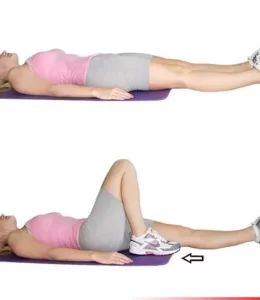
- Active knee flexion in high sitting
- First of all, the physiotherapist should tell the patient to take a comfortable position, such as high sitting. Then, the physiotherapist gives the command to the patient to bend the knee as far as possible but does not hold this position at the endpoint. Do ten repetitions per session. Do three sessions per day.
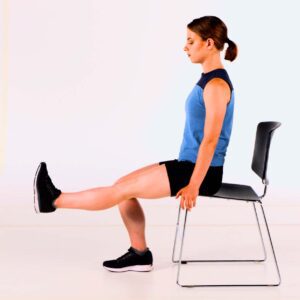
- Active knee extension in high sitting
- To embark with, a physical therapist should tell a patient to take a relaxed position, such as high sitting. After that, a therapist gives the command to a patient to straighten the knee. Do ten repetitions in one session. Do three sessions in one day.


